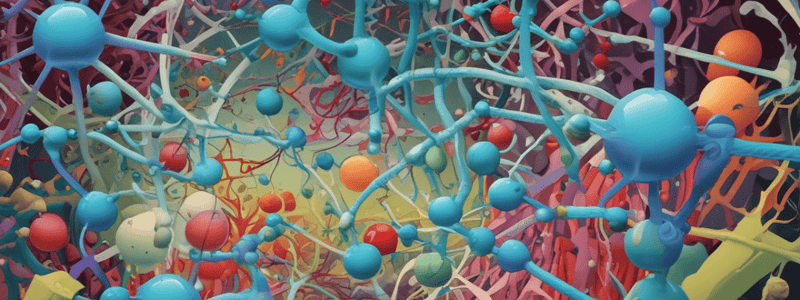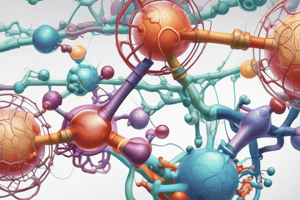Podcast
Questions and Answers
What is the term for the increase or decrease in binding affinity of other sites due to the binding of an effector molecule?
What is the term for the increase or decrease in binding affinity of other sites due to the binding of an effector molecule?
- Cooperativity
- Allosterism (correct)
- Feedback inhibition
- Homotropic regulation
What type of allosteric modulator is a substrate for its target enzyme?
What type of allosteric modulator is a substrate for its target enzyme?
- Negative allosteric
- Homotropic (correct)
- Heterotropic
- Positive allosteric
What is the term for the increase in binding affinity of other molecules due to the binding of one molecule?
What is the term for the increase in binding affinity of other molecules due to the binding of one molecule?
- Negative cooperativity
- Positive cooperativity (correct)
- Feedback inhibition
- Allosterism
What is the term for the decrease in binding affinity of other molecules due to the binding of one molecule?
What is the term for the decrease in binding affinity of other molecules due to the binding of one molecule?
What type of allosteric modulator is not a substrate for its target enzyme?
What type of allosteric modulator is not a substrate for its target enzyme?
What is the term for the regulation of an enzyme's activity by a substance that binds at a second site?
What is the term for the regulation of an enzyme's activity by a substance that binds at a second site?
What is the term for a protein that has its biological activity affected by the binding of other substances?
What is the term for a protein that has its biological activity affected by the binding of other substances?
What is the term for the inhibition of an enzyme's activity by a substance that binds at a second site?
What is the term for the inhibition of an enzyme's activity by a substance that binds at a second site?
What is the example of an enzyme that is regulated by both its substrate and other molecules?
What is the example of an enzyme that is regulated by both its substrate and other molecules?
What is the term for the regulation of an enzyme's activity by a substrate?
What is the term for the regulation of an enzyme's activity by a substrate?
What is the primary mechanism by which allosteric control regulates enzyme activity?
What is the primary mechanism by which allosteric control regulates enzyme activity?
What is the most common type of reversible covalent modification?
What is the most common type of reversible covalent modification?
What is the term for the process by which an enzyme is activated by cleavage of non-active protein?
What is the term for the process by which an enzyme is activated by cleavage of non-active protein?
What is the characteristic exhibited by allosteric enzymes?
What is the characteristic exhibited by allosteric enzymes?
What is the term for the binding of small molecules to an enzyme at sites other than the active site?
What is the term for the binding of small molecules to an enzyme at sites other than the active site?
What is the result of effector binding to an allosteric enzyme?
What is the result of effector binding to an allosteric enzyme?
What is the term for the changes that occur when a binding site of a protein or receptor is activated or deactivated?
What is the term for the changes that occur when a binding site of a protein or receptor is activated or deactivated?
What is the primary difference between allosteric and proteolytic activation?
What is the primary difference between allosteric and proteolytic activation?
What is the term for the attachment of a phosphate group to a protein?
What is the term for the attachment of a phosphate group to a protein?
What is the characteristic of allosteric enzymes that allows them to exhibit cooperativity?
What is the characteristic of allosteric enzymes that allows them to exhibit cooperativity?
What does the enzyme CTP synthetase catalyze?
What does the enzyme CTP synthetase catalyze?
What type of regulation is used by feedback inhibition?
What type of regulation is used by feedback inhibition?
What is the organization of the ATCase catalytic unit?
What is the organization of the ATCase catalytic unit?
How many models are used to explain allosterism and cooperativity?
How many models are used to explain allosterism and cooperativity?
What is the name of the model proposed by Wyman, Monod, and Changeux in 1965?
What is the name of the model proposed by Wyman, Monod, and Changeux in 1965?
What is the main feature of the Sequential Model?
What is the main feature of the Sequential Model?
What is unique to the Sequential Model of behavior?
What is unique to the Sequential Model of behavior?
What is the main difference between the Concerted Model and the Sequential Model?
What is the main difference between the Concerted Model and the Sequential Model?
What is the induced-fit model of substrate binding?
What is the induced-fit model of substrate binding?
What is the function of allosteric activators in the Concerted Model?
What is the function of allosteric activators in the Concerted Model?
What is the principle behind the induced-fit protocol of substrate binding?
What is the principle behind the induced-fit protocol of substrate binding?
What is the result of substrate binding to one subunit of an enzyme?
What is the result of substrate binding to one subunit of an enzyme?
What is the purpose of phosphorylation in enzyme activity?
What is the purpose of phosphorylation in enzyme activity?
What is the term for the inactive precursor of an enzyme that is converted to its active form by proteolysis?
What is the term for the inactive precursor of an enzyme that is converted to its active form by proteolysis?
What is the role of a coenzyme in an enzymatic reaction?
What is the role of a coenzyme in an enzymatic reaction?
What is the function of NAD+ in redox reactions?
What is the function of NAD+ in redox reactions?
What is the effect of substrate binding to an enzyme on its activity?
What is the effect of substrate binding to an enzyme on its activity?
What is the term for the process of adding or removing a phosphate group from an enzyme?
What is the term for the process of adding or removing a phosphate group from an enzyme?
What is the result of phosphorylation on a serine, threonine, or tyrosine residue?
What is the result of phosphorylation on a serine, threonine, or tyrosine residue?
What is the purpose of a zymogen?
What is the purpose of a zymogen?




